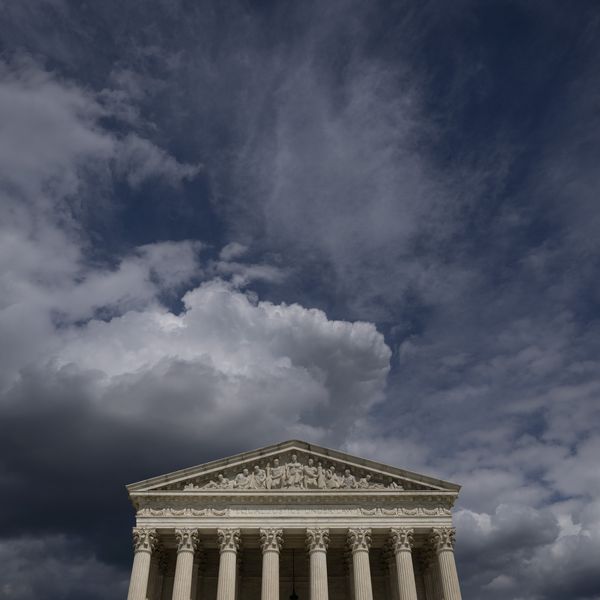
When the video came out and people of color expressed how they felt about it, many white people did not respond by listening. (Photo: University of Wisconsin-Madison Homecoming Committee)
What Life on the Margins Feels Like
A recent uproar on my campus reveals the pain young people of color feel at being treated like "others."
My campus, the University of Wisconsin-Madison, is in an uproar over a video to promote the school's homecoming that features no students of color.
When marginalized people are represented, it's often to serve a purpose for the dominant group, without challenging their default status as the norm.
We are one of the whitest schools in the country, but we are not unique in having a race problem. In that regard, we're as American as apple pie. Or, rather, cheddar cheese.
As a white person, I will never truly know what it feels like to be a person of color, on our campus or anywhere else. I will not even try to speak to an experience I've never had.
What I can offer is a perspective as a person with other marginalized identities (I'm a queer, disabled woman) who has led countless discussions about race and racism with UW students in the classroom. I listen to my students of all races, and I learn from them.
Many of these students experience hatred or prejudice, but that's not the only way they're marginalized. Just as often, it's a product of constantly seeing the dominant group (straight, male, white, able-bodied, cisgender, middle to upper class) treated as the default, the norm, or the universal--while your group is treated as "other."
Their story is taught in history and literature classes. Yours is taught in "ethnic studies" or "women's studies" or "LGBTQ studies," whatever the case may be. They are "mainstream." You exist in the margins.
Often marginalized groups are simply invisible, like queer people in animated Disney movies or people of color in UW's homecoming video. When marginalized people are represented, it's often to serve a purpose for the dominant group, without challenging their default status as the norm.
It's hard to convey how much this hurts, to be always treated as an "other," to never see representations of people like you that resonate with your actual life experiences. To be expected to live in someone else's subjectivity while they never have to live in yours.
When you do try to explain your perspective to someone in the dominant group, often they refuse to listen. It's exhausting and painful to debate and argue your own humanity to someone who denies it.
I can't speak to exactly how people of color feel about the homecoming video, but I know this: They are experiencing that video in the context of a lot of other racism that they live with every day, that the university pays lip service to addressing while not addressing it.
I can't speak to exactly how people of color feel about the homecoming video, but I know this: They are experiencing that video in the context of a lot of other racism that they live with every day, that the university pays lip service to addressing while not addressing it.
In all likelihood, the negative reaction isn't just about the video. It's the video on top of everything else.
Moreover, when the video came out and people of color expressed how they felt about it, many white people did not respond by listening. If you read comments posted online about this issue, many are from white people who express anger at people of color for complaining.
Whatever harm or hurt the initial video caused, comments like that make it worse. A lot worse.
My graduate research is on conflict resolution. The path to resolving differences requires listening to one another, treating one another with respect, and acknowledging one another's humanity.
In this case, a better response would have been to listen to those hurt by the video, learn how it feels to be in their shoes, and ask what should be done to make things right going forward.
An Urgent Message From Our Co-Founder
Dear Common Dreams reader, The U.S. is on a fast track to authoritarianism like nothing I've ever seen. Meanwhile, corporate news outlets are utterly capitulating to Trump, twisting their coverage to avoid drawing his ire while lining up to stuff cash in his pockets. That's why I believe that Common Dreams is doing the best and most consequential reporting that we've ever done. Our small but mighty team is a progressive reporting powerhouse, covering the news every day that the corporate media never will. Our mission has always been simple: To inform. To inspire. And to ignite change for the common good. Now here's the key piece that I want all our readers to understand: None of this would be possible without your financial support. That's not just some fundraising cliche. It's the absolute and literal truth. We don't accept corporate advertising and never will. We don't have a paywall because we don't think people should be blocked from critical news based on their ability to pay. Everything we do is funded by the donations of readers like you. Will you donate now to help power the nonprofit, independent reporting of Common Dreams? Thank you for being a vital member of our community. Together, we can keep independent journalism alive when it’s needed most. - Craig Brown, Co-founder |
My campus, the University of Wisconsin-Madison, is in an uproar over a video to promote the school's homecoming that features no students of color.
When marginalized people are represented, it's often to serve a purpose for the dominant group, without challenging their default status as the norm.
We are one of the whitest schools in the country, but we are not unique in having a race problem. In that regard, we're as American as apple pie. Or, rather, cheddar cheese.
As a white person, I will never truly know what it feels like to be a person of color, on our campus or anywhere else. I will not even try to speak to an experience I've never had.
What I can offer is a perspective as a person with other marginalized identities (I'm a queer, disabled woman) who has led countless discussions about race and racism with UW students in the classroom. I listen to my students of all races, and I learn from them.
Many of these students experience hatred or prejudice, but that's not the only way they're marginalized. Just as often, it's a product of constantly seeing the dominant group (straight, male, white, able-bodied, cisgender, middle to upper class) treated as the default, the norm, or the universal--while your group is treated as "other."
Their story is taught in history and literature classes. Yours is taught in "ethnic studies" or "women's studies" or "LGBTQ studies," whatever the case may be. They are "mainstream." You exist in the margins.
Often marginalized groups are simply invisible, like queer people in animated Disney movies or people of color in UW's homecoming video. When marginalized people are represented, it's often to serve a purpose for the dominant group, without challenging their default status as the norm.
It's hard to convey how much this hurts, to be always treated as an "other," to never see representations of people like you that resonate with your actual life experiences. To be expected to live in someone else's subjectivity while they never have to live in yours.
When you do try to explain your perspective to someone in the dominant group, often they refuse to listen. It's exhausting and painful to debate and argue your own humanity to someone who denies it.
I can't speak to exactly how people of color feel about the homecoming video, but I know this: They are experiencing that video in the context of a lot of other racism that they live with every day, that the university pays lip service to addressing while not addressing it.
I can't speak to exactly how people of color feel about the homecoming video, but I know this: They are experiencing that video in the context of a lot of other racism that they live with every day, that the university pays lip service to addressing while not addressing it.
In all likelihood, the negative reaction isn't just about the video. It's the video on top of everything else.
Moreover, when the video came out and people of color expressed how they felt about it, many white people did not respond by listening. If you read comments posted online about this issue, many are from white people who express anger at people of color for complaining.
Whatever harm or hurt the initial video caused, comments like that make it worse. A lot worse.
My graduate research is on conflict resolution. The path to resolving differences requires listening to one another, treating one another with respect, and acknowledging one another's humanity.
In this case, a better response would have been to listen to those hurt by the video, learn how it feels to be in their shoes, and ask what should be done to make things right going forward.
My campus, the University of Wisconsin-Madison, is in an uproar over a video to promote the school's homecoming that features no students of color.
When marginalized people are represented, it's often to serve a purpose for the dominant group, without challenging their default status as the norm.
We are one of the whitest schools in the country, but we are not unique in having a race problem. In that regard, we're as American as apple pie. Or, rather, cheddar cheese.
As a white person, I will never truly know what it feels like to be a person of color, on our campus or anywhere else. I will not even try to speak to an experience I've never had.
What I can offer is a perspective as a person with other marginalized identities (I'm a queer, disabled woman) who has led countless discussions about race and racism with UW students in the classroom. I listen to my students of all races, and I learn from them.
Many of these students experience hatred or prejudice, but that's not the only way they're marginalized. Just as often, it's a product of constantly seeing the dominant group (straight, male, white, able-bodied, cisgender, middle to upper class) treated as the default, the norm, or the universal--while your group is treated as "other."
Their story is taught in history and literature classes. Yours is taught in "ethnic studies" or "women's studies" or "LGBTQ studies," whatever the case may be. They are "mainstream." You exist in the margins.
Often marginalized groups are simply invisible, like queer people in animated Disney movies or people of color in UW's homecoming video. When marginalized people are represented, it's often to serve a purpose for the dominant group, without challenging their default status as the norm.
It's hard to convey how much this hurts, to be always treated as an "other," to never see representations of people like you that resonate with your actual life experiences. To be expected to live in someone else's subjectivity while they never have to live in yours.
When you do try to explain your perspective to someone in the dominant group, often they refuse to listen. It's exhausting and painful to debate and argue your own humanity to someone who denies it.
I can't speak to exactly how people of color feel about the homecoming video, but I know this: They are experiencing that video in the context of a lot of other racism that they live with every day, that the university pays lip service to addressing while not addressing it.
I can't speak to exactly how people of color feel about the homecoming video, but I know this: They are experiencing that video in the context of a lot of other racism that they live with every day, that the university pays lip service to addressing while not addressing it.
In all likelihood, the negative reaction isn't just about the video. It's the video on top of everything else.
Moreover, when the video came out and people of color expressed how they felt about it, many white people did not respond by listening. If you read comments posted online about this issue, many are from white people who express anger at people of color for complaining.
Whatever harm or hurt the initial video caused, comments like that make it worse. A lot worse.
My graduate research is on conflict resolution. The path to resolving differences requires listening to one another, treating one another with respect, and acknowledging one another's humanity.
In this case, a better response would have been to listen to those hurt by the video, learn how it feels to be in their shoes, and ask what should be done to make things right going forward.

